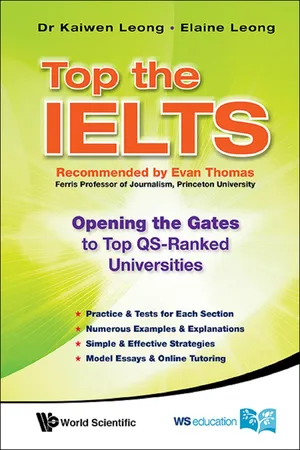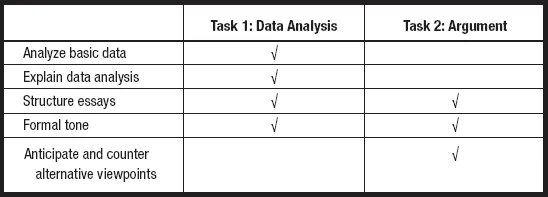![]() The Academic Writing Section
The Academic Writing Section![]()
Introduction
The academic writing section consists of two tasks. Most students think that the most important goal is to write English that is grammatically correct. This is wrong. Just imagine, you could write an essay that has sentences with not more than four words each:
Dogs exist nearly everywhere. Dogs are nice. Many people have dogs. Most dogs are pets. People like their company. They are loyal companions.
As you can see, the example above is grammatically correct. But it is also very dry and unstructured. It is not clear what insights the reader can obtain from the essay, nor why it was written at all.
And so, the IELTS requires more than just correct English. It also requires you to:
1)Be able to analyze basic data
2)Be able to use English to explain your analysis (this also means acquiring the vocabulary necessary for such writing)
3)Apply the correct formal tone in English writing
4)Structure essays clearly with an argument that is supported by specific points
5)Display maturity in making arguments by also being able to consider and also counter alternate viewpoints
Task 1 (20 minutes)
The first writing task usually consists of some form of graphic stimulus, such as some charts and graphs. You will be asked to summarize information and present an analysis of the data in writing. This is something unique to the IELTS — you would not, for example, find this kind of writing task in the TOEFL.
Many students find this task challenging because they do not know how to interpret the data given and they lack the appropriate vocabulary needed to present their analysis. Words such as “percentage,” “year-on-year increase” and “incremental” may not come naturally to everyone.
Furthermore, the recommended time for this section is a mere 20 minutes. This means that you must ensure that you have the required vocabulary and thought processes on hand so that you can complete the analysis in this very short period of time.
Task 2 (40 minutes)
The second writing task will present a scenario to you and you will have to pick a viewpoint. More importantly, you will have to justify why you chose that viewpoint. Most students think that they can justify their viewpoint solely based on how they see it. But, what the IELTS is also looking for — and what you can observe from the model answers provided — is the ability to anticipate and give justified responses to those who hold the opposing view.
In contrast to Task 1, Task 2 focuses more on your ability to create nuanced arguments. You may think that this is easier, given that you don’t have to memorize analytical vocabulary like you did for Task 1, but there are certain techniques you must acquire before you can do it well.
In summary, the abilities that will be tested via the two tasks are as follows:
As you can see from the above, there are some skills that are more important for Task 1, and there are others that are more relevant for Task 2. On top of that, there are skills that are universal to both tasks, such as having a solid structure and applying a formal academic tone to the writing.
Bearing this in mind, the Writing Section is structured as follows:
| 1) | Structure |
| | a) | Drawing a Blueprint |
| | b) | Introductions |
| | c) | Connecting Paragraphs |
| | d) | Concise Conclusions |
| 2) | Tone |
| | a) | Formal Writing |
| 3) | Data Analysis Skills |
| | a) | Analytic Vocabulary |
| | b) | Generating Insights |
| 4) | Argumentative Skills |
| | a) | Forming a Viewpoint |
| | b) | Countering Arguments |
![]()
1a
Drawing a Blueprint
Introduction
A blueprint is something that construction companies must prepare before building a house or any other building. In a way, writing is a lot like building a house. You need to make sure you have a clear idea of what you want to convey, and how you want to do this effectively.
The essay below is an example of an essay that suffers from poor structure. This was written by a student preparing for the IELTS, whom we will call “Student A” for now.
Essay Question: Some people say that advertising is such a key factor in driving consumption that sales figures are more of a reflection of effective advertising rather than a genuine need for the product.
To what extent do you agree or disagree with this opinion?
Give reasons for your answer and include any relevant examples from your own knowledge or experience.
Write at least 250 words.
[Poor Structure]:
Advertisements are shown everywhere to persuade people to buy products. Some people think that the high sales of popular consumer goods reflect the power of advertising and not the real needs of the society in which they are sold. I do not agree with this claim.
Comment: In the introduction, the student stated that she does not agree that the high sales of goods reflect the power of advertising.
However, just take a look below at the first paragraph of the main body. The student strongly states: “it is true that advertisements can promote manufacturers’ sales.” This immediately confuses the reader, who will begin to wonder whether the student agrees or disagrees with the statement. When you have confusion over a basic detail such as this, then it is very likely your grade will take a hit.
As we can see, it is true that advertisements can promote manufacturers’ sales. Manufacturers will invest quite a large amount of money to design amazing product introduction videos or pictures so that people can remember their products at first sight. Furthermore, good quality products advertisements that are shown on television or in magazines can make people buy products compulsively. They can also inform consumers about the advertised products. Although costumers do not really need the products, they will sometimes follow the trends.
On the other hand, it is the people’s decision whether or not to buy a product. People have a wide range of options from which they can select which product they want to buy. They will combine different factors such as price, quality, manufacturer and brand. Advertisement are only one part of the equation.
Moreover, people have budgets, which influence their dec...

